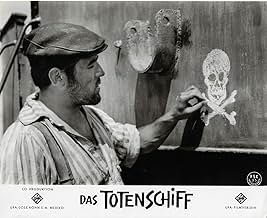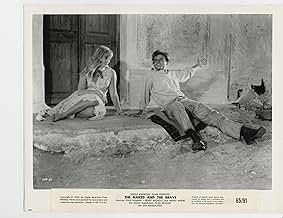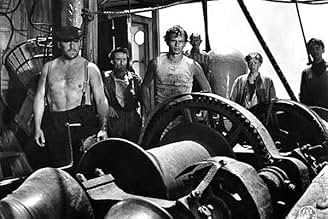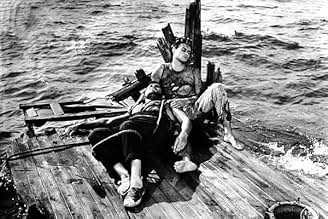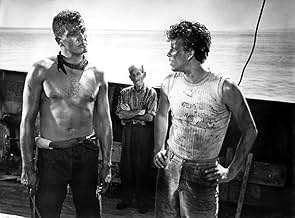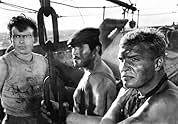Agrega una trama en tu idiomaAfter a line of mischief Philip Gale, an American sailor, is lured into hiring on the "Yorikke", a tramp cargo, by Lawski, a stoker from Poland. Still, the two become friends within the motl... Leer todoAfter a line of mischief Philip Gale, an American sailor, is lured into hiring on the "Yorikke", a tramp cargo, by Lawski, a stoker from Poland. Still, the two become friends within the motley crew of losers from all nations. Gale and his new companion soon are more than disillus... Leer todoAfter a line of mischief Philip Gale, an American sailor, is lured into hiring on the "Yorikke", a tramp cargo, by Lawski, a stoker from Poland. Still, the two become friends within the motley crew of losers from all nations. Gale and his new companion soon are more than disillusioned: the "Yorikke" is far from seaworthy and more of a coffin than a ship, work is close... Leer todo
- Dirección
- Guionistas
- Elenco
- Mme. Loureau, Mylénè's mother
- (sin créditos)
- Dirección
- Guionistas
- Todo el elenco y el equipo
- Producción, taquilla y más en IMDbPro
Opiniones destacadas
Despite my ignorance, it is not difficult to suppose that a film like «The Ship of Death» emerged in difficult times, a year after West Germany finally recognized the existence of East Germany, until the country was unified in 1990. While the Eastern products were almost absent, West German films sporadically showed up in our screens in the 1950-60s. They were bland, although not as puritanical as what arrived from Mexico, the US or Argentina. Films like «The Third Sex» were controversial; the trilogy of "Liane, the White Slave" excited us with its sexy stars, while Senta Berger in «Ramona» proposed a free structure of the musical.
Also from 1959 was the war drama «The Bridge» by Bernhard Wicki, which had a better reception than «The Ship of Death.» Both films were released when filmmakers such as Edgar Reitz and Alexander Kluge were already around, as forerunners of the "new German cinema" that produced highly significant works, signed by Fassbinder, Wenders, Herzog, Schlondorff, and others.
Fortunately, the W. A. Murnau Foundation rescued and restored «The Ship of Death» (co-produced with Mexico), the most outstanding work in the filmography of director Georg Tressler, based on the novel by B. Traven, a German who lived in Mexico, author of «The Treasure of the Sierra Madre» and «Macario», whose real identity, to this day, is unknown. The film starred the Berliner Horst Buchholz, as Phillip Gale alias Pippip, a young American sailor who, left without money or papers, ends up working on a decrepit ship used for smuggling.
According to literary critics, the novel by the enigmatic Traven is an accurate critique of capitalism. In the film, something similar is expressed through situations that reveal corruption, greed, and labor exploitation, on the one hand; and the bureaucracy and inefficiency of state organs and diplomatic missions, on the other. The plot is further balanced by the description of the friendship and solidarity between Pippip and the Polish sailor Lawski (Mario Adorf) and a short romantic interlude between Pippip and a French girl (Elke Sommer).
The drama reaches the expected outcome, with an ending too pessimistic for 1959. The films I remember from those years tended to sweeten the stories to generally give us happy endings. «The Ship of Death» does not and, although its conclusion could be considered an "open ending", the tragedy is eloquent.
The film is well acted, vividly photographed and distinctly better than we have any right to expect.
It depicts a fugitive sailor's time on a tramp steamer, with lots of tough guys, much grubby detail, a catastrophe and an amazing final image that will stay with you long after you've forgotten the rest of the film. Very worthwhile.
When will German DVD makers get smart and put English and French subtitles on their discs? A little extra expense would give them a worldwide clientele instead of just selling to two countries.
Some may think that the movie drags on in its first third ,but when you know the ( somber,at the time ,totally unexpected ) denouement , you realize that these sequences were necessary to make acquaintance with a young naive sailor ,rejected by everyone because he's got no papers ; the meeting with the young peasant girl (Elke Sommer) is actually the condemned man's last cigarette .
When he goes aboard the doomed Schiff , bizarre warnings trouble the viewer : "they caught him in their net" say the harbor men, a strange sign tells the sailor some kind of "abandon all hope,ye who enter here" ..
The work in the coal bunker is depicted in a terrifying realistic way:the fiery furnaces of Hell indeed! The hope to get out of this nightmare during the call will be short-lived ; both Buchholz and Adorf shine, in the final scenes ,worthy of the Raft of the Medusa"!
Great and underrated !
¿Sabías que…?
- TriviaItalian censorship visa #34628 delivered on 5/5/61.
- ConexionesReferenced in King Kongs Faust (1985)
- Bandas sonorasNamenlos
Music & Lyrics by Roland Kovac
Sung by Horst Buchholz
Selecciones populares
Detalles
- Fecha de lanzamiento
- Países de origen
- Idioma
- También se conoce como
- The Naked and the Brave
- Locaciones de filmación
- Productoras
- Ver más créditos de la compañía en IMDbPro
- Tiempo de ejecución1 hora 37 minutos
- Color
- Mezcla de sonido
- Relación de aspecto
- 1.66 : 1
Contribuir a esta página



